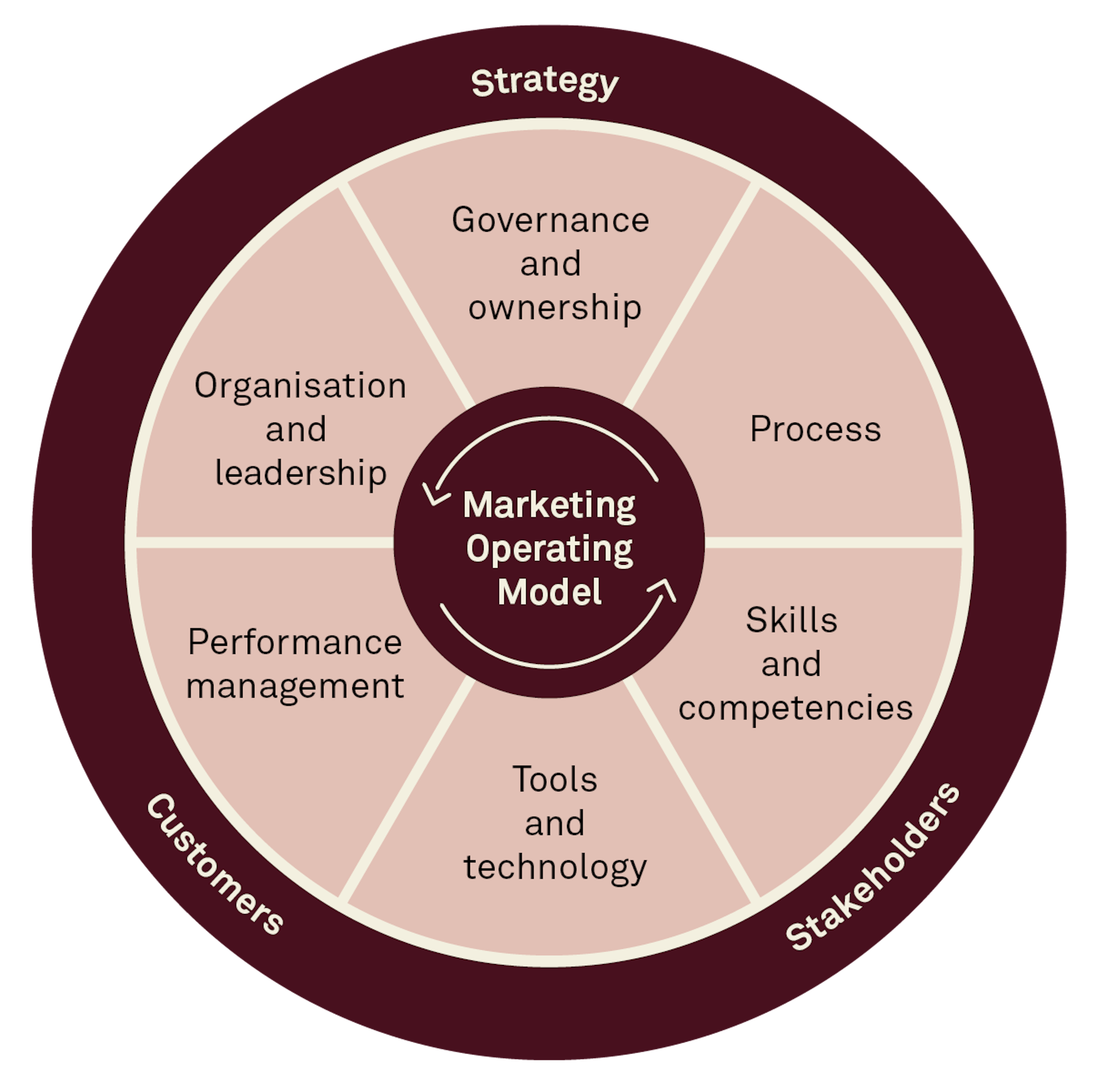Article
A framework for designing a solid, future-ready marketing operating model
Published
2 September 2024
For marketing organisations, the formula for success has changed radically. CMOs face steadily increasing customer expectations, new marketing channels and a flood of ever-expanding data. And as something new, creativity is being redefined by the rapid pace of change, e.g. due to generative AI.
This new situation may seem like an ocean of unlimited opportunities, but in an environment characterised by economic uncertainty and changing market dynamics, expectations of cost efficiency and agility are through the roof.
That is why CMOs need to be laser-focused on strengthening their operations and proving their value. It is all about streamlining processes and delivering measurable results.
A blueprint for designing your marketing operating model
So how do you navigate this ever-changing business environment while still delivering on performance expectations? The first step is to build a solid, future-ready marketing operating model.
We have developed a detailed framework that empowers CMOs to face these challenges directly and achieve tangible, measurable success – we call it the marketing operating model framework. The framework is engineered to address the full spectrum of complexities, offering a definitive “blueprint” for operational excellence.
The framework is designed to support a specific issue, whether it is performance management or more streamlined processes, but it can also be used to address the full design of a marketing operating model in a holistic and balanced manner.
The framework consists of three guiding principles and six dimensions.
Guiding principles
The three guiding principles are strategy, customers and stakeholders. The guiding principles set the direction for the analysis of the six dimensions. They help bring the marketing leadership team together around a set of key objectives for designing or adjusting the operating model to ensure it is fit for purpose.
The leadership team typically tries to answer key questions such as:
- What is our business strategy, and how do we align our marketing strategy and operating model to support it?
- To what extent should we insource or outsource key activities?
- To what extent should we centralise or decentralise key activities/functions?
- What strategic decisions have we made that drive our priorities and workflow?
- What are our top priorities for delivering business value, and how are we performing against them?
- What are the critical touchpoints in the customer journey, and how can we improve them?
The six dimensions
The six dimensions are the essence of the marketing operating model, and they must be designed to fit together.
Significant changes in one dimension may require altering other dimensions, which is why we talk about a balanced approach.
How to get started and key success criteria
Our experience from working with clients on designing marketing operating models has highlighted the importance of four critical elements when running successful marketing operating model projects.
- Involve management broadly: involve senior management to ensure a seamless link to the current strategy, embedding the new design and fostering their willingness to invest. Equally important, involve marketing leaders throughout the design process – from assessment to final road map – to guarantee buy-in and enable a swift project launch.
- Align design with strategy and stick to it: ensure that your design is based on the company strategy and converted into actionable directions for your future marketing set-up. Adhere strictly to your design principles when solutions are suddenly questioned – this provides clear direction and reduces uncertainty.
- Keep a fast pace in the design: organise the project using short-interval sprints to keep participants focused and engaged, which leads to optimal design results. Make a clear agreement with each participant about their time commitment to the project, including necessary preparatory work.
- Prepare for initiation: to ensure a rapid initiation, prebook the resources and competencies needed to implement the initiatives. In addition, assess whether existing resources can handle the implementation or whether there is a need to recruit or engage external consultants.
Want to know more about our experience in designing a marketing operating model and the proven impact it has had on our clients? Contact us.
We have seen remarkable transformations and would love to share our insights with you.
About the author
Mads Vinholdt is a partner in the Commercial Transformation team at Implement Consulting Group. He has extensive experience in defining operating models and go-to-market strategies for global organisations. As an expert in the intersection between sales and marketing, he advises leaders on how to elevate their capabilities and organisations to drive top-line growth.
Related0 4
Article
Read more
The marketing capability gap
Insights on how marketing organisations can build the capabilities that unlock growth.Article
Read more
Marketing efficiency
Think like a CFO and free up 20-30 per cent of your marketing budgetArticle
Read more
Winning Generation Z: A new approach to brand identity
The future of brand building in the FMCG industry.Article
Read more





